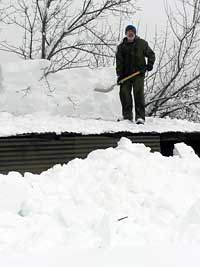 |
 |
 |
 |
 |
 |
 |
 |
 |
 |
|
Greentree Naturals Newsletter Winter 2011
Thom Shoveling Snow I am one of those weird people who are happy that it is snowing on this 27th day of February. Thom keeps track of how many times he blows the snow with the snow blower and today will be his 19th blowing this winter. You have to be into dealing with snow if you live in northern Idaho. When you wake up in the morning and the trees are freshly flocked with fluffy white ice crystals, you know that a part of this day is going to involve moving snow around. It always starts with shoveling the front steps and a path to the chickens and goats. We keep a hoop house up all winter to store hay and straw in up by the house. The structure is not sound enough to support much of a snow load, so we have to go inside and push the snow off. You put your arms up over your head and push up and down on the plastic covering of the hoop house until the snow slides off. Once it slides off the top, you have to then shovel off the sides where it has piled up. The weight of the snow pushes in on the sides and stretches the plastic, so it has to be moved. Once these basics have been met, then the snow blower comes out. It is truly an amazing machine and moves snow around quite successfully. Thom will blow out the entire driveway, around our parked van and truck, move the rigs (anything with four wheels is referred to as a “rig” here), blow where they were parked, get it cleared out, move the rigs back…. It’s a process that takes time and patience. Thom is so good at it. I have to say that I haven’t personally used the snow blower this winter, but know how to do it and managed the snow by myself for the past two winters because Thom was gone working. Happy that he is home this winter! Winter gives me the time to do things that I never have time to do in the spring-summer-fall because we are farming. I have actually read TWO books this winter; granted they were books about farming, but I read, none-the-less. I read Joel Salatin’s “The Sheer Ecstasy of being a Lunatic Farmer”, which was interesting, entertaining and thought provoking. I can relate to a lot of what he writes about and found myself taking notes as I read this book. If it had been my own book, I would have taken a highlighter to pertinent statements, but it was borrowed from a farmer friend who insisted that I read it. I taught a fall Sustainable Small Acreage Farming and Ranching course for UI again. This was the fourth year I have done this as a contractor for the Cultivating Success program at the University of Idaho. I am currently an instructor for a pilot on-line course of the same topic; we are in our seventh week of a twelve week course. Basically, the course is designed to teach how to write a farm / business plan. The exercises really make a person think seriously through the entire process of running a successful and sustainable farm. I have had students come up to me afterward and thank me for helping them see the realities associated with becoming a farmer. Just like any small business, planning is key to success. I wish I would have taken a course like this when we first started out with our small farm enterprise. I might have done things a bit differently. People often refer to us as “successful” at what we do, which sometimes has me scratching my head. One part of me identifies “success” as making money, having money to buy what you need to buy and not having to worry too much about it. On the other hand, if we weren’t successful in the sense of accomplishment that comes with growing this incredible garden, raising happy chickens, and feeding our community, we might be working in Walmart or doing something that we didn’t love so much. Success can be measured in so many ways. I have to remind myself to be grateful for what we have sometimes. What we do is an incredible amount of work, but it is indeed “right livelihood” as my friend Marilyn calls it. There has never been a day that I didn’t want to go into the garden to go to work, and this was one of our goals of doing what we are doing. Granted, we are getting older, and the work is getting more challenging for our bodies to endure. For Thom, at 62 years old, his health is amazing for a man who has planted over a million and a half trees. Arthritis is showing its growling presence in his hands and knuckles from pounding the ground to get the trees into the earth. Body parts aren’t necessarily guaranteed for a lifetime and you can’t exactly get an extended warranty on worn out knees, shoulders and backs. We always do the best that we can, and know that some days our best is going to be less than other days. We are preparing for another growing season at Greentree Naturals. Most of our seeds have arrived in the mail, and I will start seedlings in the attached greenhouse the second week of March. Our CSA members are sending in their reservations for their season share of the garden and I’ll be contacting local restaurants about possible summer provisions to their fine dining establishments when the growing season is at its peak. I’m working on developing a couple of grants, one working with a local homeless shelter to create a community garden project. I call it “give a man a fish” proposal. You know the old Chinese proverb: “Give a man a fish and he eats for a day; teach a man to fish and he eats for a lifetime.” We will continue with the WSU research project that we’ve been working on for the past two years. This will be the final year of that project. Of course, we are still trying to figure out how we can come up with the money to complete the commercial sized greenhouse project and turn it into a sustainable model to share with others. Money is often the determining and/or inhibiting factor for projects to get done. I just developed a presentation/workshop for a compact disc on Planning the Garden. I usually teach this workshop on the farm in May and have come to realize that the information needs to get out there sooner than that to be timely. My purpose of producing this “workshop” on CD was to share information about planning the garden when it is most needed, and outline it in such a way that you don’t have to read an entire book to figure out what you need to do to plan for a successful gardening season. So far, this project has been a labor of love with the hope that we will make some successful sales to help with making our small farm more sustainable. It is available for sale on our Web site now, so if you know anyone that might benefit from such a thing, we’d be happy to sell them a CD. I’m not meaning to make a sales pitch here. Mostly wanted you to know what I was up to. The purchasing details are on this page. ~ Diane
Moose on the Looseby Diane Green
A Moose mama and yearling came to visit us about a month ago. The following is our Moose Diary: The first day, we were in awe of their size and beauty and found ourselves saying “what an amazing place that we live in where moose will actually come and visit us right outside our door!” Second day, we found them sleeping ON THE DECK. “Amazing! They don’t even care that we are right here!” Our dog Annie has given up barking at them because they don’t respond. She thinks they are our new livestock. Third day, “the moose are eating my forsythia but it needed to be pruned anyhow.” Fourth day, “the moose are eating the ornamental Mtn. Ash”…so we threw snowballs at them. Note to self: Moose don’t like snowballs being thrown at them and will charge you if you do. Fifth day, “the moose are INSIDE the chicken yard eating the cherry trees! Those gosh darned animals are eating everything….I wonder what the law is for shooting a marauding moose?” Sixth day, “how many ways can you discourage a moose and not get charged by the animal?” Snowballs didn’t work. Diane got out two cow bells and rang them as loud and obnoxiously as possible by running around the yard while Thom banged garbage can lids….we may have something here for making a new band on the farm…call it the “moose scooten boogie band”. Day seven – no moose here. Our neighbors called to say they have a mama moose and yearling visiting and how lovely they are…. Day eight – neighbors asking how we got rid of them.
|
2003 Rapid Lightning Road, Sandpoint, Idaho 83864 • 208-263-8957 • info@greentreenaturals.com
Site Design by Logical Expressions, Inc.


